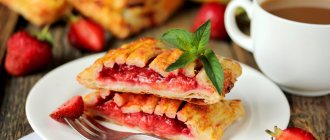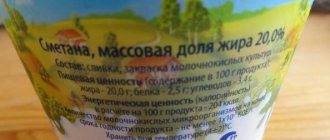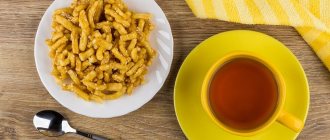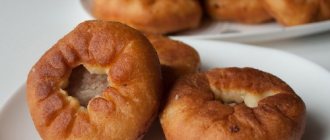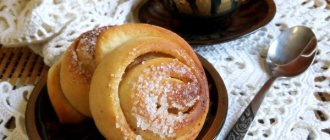Puff pastry is a base product for baking. It produces light, crispy textured products. Puff pastries are suitable for creating both sweet cookies and vegetable and meat pies.
Currently, a wide range of ready-made dough is available on store shelves: chilled, frozen. Each of the semi-finished products has its own characteristics and composition, but the key components in it remain unchanged. This is butter or margarine, water, flour.
In small doses, baking from puff pastry is harmless. Due to the abundance of fats in the composition, it quickly saturates, serves as the main source of energy, and forms protective layers for internal organs. The benefits of a product depend on the original ingredients from which it is made.
History of origin
Currently, there are two versions of the appearance of puff pastry. The first says that the recipe for making “buttery” pastries was discovered in the ancient state of Assyria. The second originates in 1645 and is due to the student of the French pastry chef Claudia Gelet, who wanted to bake bread for his sick father. However, the classic recipe did not meet the patient's dietary requirements. Without thinking twice, the baker wrapped a piece of butter in dough mixed with water and flour, rolled it out several times, and sent it to the oven. Half an hour later, he pulled out a huge loaf of non-standard sizes, which greatly surprised the household.
After some time, the baker finalized his invention and presented it to the public in Paris. The new layered masterpiece gained wide popularity among local residents, which brought money and fame to the creator. He subsequently moved to Florence and continued his business. At the same time, the recipe know-how was kept in the strictest confidence. However, there is nothing secret that would not become obvious. Soon the ingredient composition of puffed pastries was discovered and the culinary field experienced a “puff boom” that has not passed to this day.
Types of test
All puff pastries are prepared from cold water, animal fat, and sifted premium wheat flour. To improve the taste and increase the elasticity of the dough, additional ingredients are added to it - cognac or vodka. Depending on the composition, the baking base is prepared with or without the addition of yeast. In the first case, the dough rises due to the evaporation of oil and the use of fermentation cultures. In the second, only due to the effect produced by oil vapors. That is why in yeast-free dough there are about 150 layers, and in yeast dough this figure varies from 24 to 160. At the same time, “160” is not the limit, the number of rolls can reach up to 240 times.
Fungi that cause fermentation not only determine the chemical composition of the puff pastry product, but also affect its taste and “fragility.”
When buying ready-made packaged dough, you should carefully study what ingredients are included in it. You can often notice impurities in its composition. If these are vitamin supplements A, B, E, PP, no need to worry. The situation is much worse if harmful dyes, flavor enhancers and preservatives are found in it.
Types of puff pastry:
- Classic. To prepare the base for baking according to the classic recipe, you need to mix water and flour in equal proportions, add salt and butter. Then tuning is performed.
- Cottage cheese. To create this type of puff pastry, chilled butter, flour and cottage cheese are taken in a ratio of 1: 1: 1. The first two ingredients are thoroughly mixed, salt and baking powder are added. The cottage cheese is rubbed through a sieve and carefully mixed into the dough, which is subsequently turned into turnips.
- Creamy. To obtain an airy “milk” semi-finished product, cream (sour cream), butter and flour are taken in a ratio of 0.8: 1: 2. All components are thoroughly mixed, the dough is folded in three, rolled out, placed in the cold, otherwise the layers will stick together. Then a similar procedure is performed at least 5 times.
The process of preparing puff pastry is labor-intensive and takes at least 3 hours. However, baked goods made on its basis are distinguished by their unusual light structure and crispy layered properties.
Due to the complexity and length of preparation, housewives and businesswomen who lack free time often prefer ready-made store-bought products. However, the quality of purchased semi-finished products is sometimes questionable. To be 99% sure of the composition, freshness and naturalness of the product, it is recommended to prepare it yourself.
Calorie content of yeast-free dough per 100 grams
The calorie content of yeast-free dough per 100 grams is 329 kcal. Per 100 gram serving:
- 5.8 g protein;
- 18.4 g fat;
- 39.5 g carbohydrates.
To prepare dough without yeast you need:
- in a bowl, mix half a glass of vegetable oil and half a glass of almost boiling water;
- add a pinch of salt to the resulting mixture, stir until the salt dissolves;
- sift 2.5 cups of flour with 1 teaspoon of baking powder into the oil liquid;
- knead the dough, wrap it in film and leave for half an hour.
Chemical composition
Puff pastry made from quality ingredients has a neutral taste, plastic and pliable for preparing a variety of baked goods. It goes well with vegetable, meat, fish and sweet fillings.
Interestingly, ready-made puff pastry is considered a relative of phyllo, prepared in the Middle East, which in turn is stretched rather than rolled.
In addition, it contains less water. Nutritional value of puff pastry
| Name | Contents per 100 g of product |
| Carbohydrates | 39,3 |
| Organic acids | 38,3 |
| Water | 35,8 |
| Fats | 18,5 |
| Squirrels | 5,9 |
| Alimentary fiber | 1,0 |
| Ash | 0,5 |
Chemical composition of puff pastry
| Name | Concentration of nutrients per 100 g of product, mg | |
| Vitamins | ||
| Choline (B4) | 30,4 | |
| Tocopherol (E) | 6,7 | |
| Niacin (PP) | 0,6 | |
| Pantothenic acid (B5) | 0,2 | |
| Retinol (A) | 0,1 | |
| Pyridoxine (B6) | 0,1 | |
| Thiamine (B1) | 0,09 | |
| Riboflavin (B2) | 0,06 | |
| Folic acid (B9) | 0,0145 | |
| Biotin (H) | 0,0012 | |
| Cobalamin (B12) | 0,00007 | |
| Macronutrients | ||
| Chlorine | 603,6 | |
| Potassium | 71,2 | |
| Phosphorus | 53,2 | |
| Sodium | 50,2 | |
| Sulfur | 46,3 | |
| Calcium | 17,3 | |
| Magnesium | 9,1 | |
| Silicon | 2,1 | |
| Microelements | ||
| Iron | 0,7 | |
| Aluminum | 0,552 | |
| Zinc | 0,475 | |
| Manganese | 0,303 | |
| Copper | 0,0613 | |
| Vanadium | 0,0473 | |
| Bor | 0,0195 | |
| Fluorine | 0,0137 | |
| Molybdenum | 0,0081 | |
| Titanium | 0,0058 | |
| Tin | 0,0053 | |
| Selenium | 0,0032 | |
| Nickel | 0,0015 | |
| Chromium | 0,0015 | |
| Cobalt | 0,0012 | |
| Iodine | 0,001 | |
Often, in the process of preparing puff pastry products, housewives are faced with two problems: it does not rise or does not bake. Why is this happening? In the first case, the cause of the trouble is the use of low-quality (expired) raw materials, placing the dough in an unheated oven, and low baking temperature (up to 230 degrees).
Puff pastry dough does not like drafts, therefore, in order for it to rise, you cannot open the window or window in the room.
In the second case, the baked goods are not baked due to the abundance of fat in the composition. As a result, the cake turns out wet, heavy and tasteless.
Calorie content of biscuit dough per 100 grams
The calorie content of biscuit dough per 100 grams is 288 kcal. 100 g contains:
- 6.8 g protein;
- 7.7 g fat;
- 52.4 g carbohydrates.
To make biscuit dough, you need:
- Pour 4 chicken eggs at room temperature into a mixer bowl, add a pinch of salt to the eggs. Beat the resulting mixture at high speed;
- add 1 cup of sugar in several additions, beat the dough thoroughly;
- sift 1 cup of flour into a bowl;
- add flour into the egg mixture in parts, not forgetting to mix the dough with a spatula;
- the finished dough is poured into a baking dish greased with vegetable or butter;
- bake the biscuit in a preheated oven for 35 - 40 minutes at a temperature of 160 degrees.
Usefulness and danger
The advantages and disadvantages of a product fully depend on its composition. In any case, this is a high-calorie product, 100 g of which contains 337-362 kcal. Dough made without yeast is considered the healthiest.
The main advantage of the puff pastry product is its high energy value, which ensures rapid saturation of the body. It is enough to eat 150-300 g of baked goods and you will get strength for the whole coming day. In addition, products made from puff pastry have excellent taste and a crispy airy structure, which not everyone can tear away from in time. Therefore, people with excess body weight should deliberately limit the consumption of processed foods or completely eliminate them from the diet, otherwise they may gain even more weight. In addition, it is recommended that diabetics and people with metabolic problems avoid the product.
The benefit of puff pastries lies in the presence of complex carbohydrates in them, which take a relatively long time to digest as opposed to empty calories. Because of this, the energy is partially annihilated, reducing the likelihood of gaining extra pounds.
However, in large quantities the product can disrupt the gastrointestinal tract and harm the heart. Due to the abundance of fats in the composition, puff pastry increases cholesterol levels in the blood. If baked goods are consumed in moderation (up to 300 g per day), then there should be no health problems.
However, with systematic abuse (exceeding the maximum established doses), low-density lipoproteins contribute to the growth of atherosclerotic plaque, which threatens the development of heart diseases (stroke, heart attack, thrombosis). In addition, a person may experience unpleasant symptoms from the digestive tract: flatulence, constipation, nausea.
In limited quantities, puff pastry products supply the body with vitamins A, B, E, H, PP, sulfur, phosphorus, chlorine, potassium, sodium, calcium, silicon, magnesium, aluminum, boron, vanadium, nickel, tin, selenium, titanium , iron, iodine, cobalt, zinc, chromium, fluorine, manganese, copper, molybdenum, organic acids.
Beneficial properties of the vitamin composition of the product:
- niacin (PP) – protects the health of the pancreas, normalizes cholesterol levels, and prevents the development of diabetes;
- B vitamins – ensure the normal functioning of the nervous system, affect the condition and development of nails, hair, teeth, bones;
- tocopherol (E) – improves the regenerative properties of tissues and blood circulation;
- retinol (A) – participates in metabolic reactions, protein synthesis, ensures normal functioning of the immune system, proper bone development, and the process of cellular renewal;
- biotin (H) – improves glucose metabolism, is a “transporter” of sulfur, relieves muscle pain, heals nervous tissue, and participates in the metabolism of carbohydrates, proteins, and fats.
Puff pastry is a source of mineral compounds that have beneficial effects on the human body. Macro- and microelements normalize the functioning of the nervous and muscular systems, help produce insulin, fight anemia, fatigue, weakness, stimulate general immunity, enhance the production of proteins, and activate a number of enzymes. In addition, they are involved in hematopoiesis, fatty acid metabolism, oxidative processes, the construction of body cells, the formation of hormones, the regulation of water metabolism, strengthen bones and teeth, and control the functioning of the endocrine system. These compounds nourish the brain and thyroid gland, improve bile secretion, relieve spasms, maintain the tone of vascular walls, provide collagen synthesis, and energy production.
Remember, the usefulness of puff pastry, like most products, depends on the quality of the original ingredients and moderation in consumption.
Calorie content of dumpling dough per 100 grams
The calorie content of dumpling dough per 100 grams is 233 kcal. In 100 g of dumpling dough:
- 8 g protein;
- 1.3 g fat;
- 50.7 g carbohydrates.
Cooking steps:
- add 200 g of sifted flour to a large bowl;
- Make a hole in the flour, add 1 chicken egg yolk and 20 g of softened butter to the hole. Mix all ingredients;
- Add a third of a glass of ice-cold salted water to the dough in small portions. Do not forget to constantly stir the resulting mixture;
- knead the dumpling dough for 10 – 20 minutes;
- Wrap the finished dough in film and leave in the refrigerator for 15 minutes.
Cooking tips
To make the baked goods airy, tasty and crispy, you must follow some rules when kneading the puff pastry.
Recommendations for housewives:
- To increase the elasticity of the dough, salt and vinegar are added to its composition. At the same time, you need to be extremely careful in quantity so as not to spoil the taste of the product. For 400 g of flour you should take no more than 15 ml of 9% vinegar.
- To obtain a golden-colored crust, brush the top of the product with a chicken egg, without touching the edges. Otherwise the dough will not rise.
- To ensure that the dough is airy and rises well, only the highest quality flour is used. At the same time, it must be sifted.
- When cutting the dough, use a well-sharpened knife, otherwise you can crumple the edges of the sheet. As a result, the appearance of the baked goods will deteriorate.
- To make it light and airy, strong alcoholic drinks (vodka, cognac) are added to the dough - no more than 15 ml per 400 g of flour.
- Cooling at all stages is a must. Otherwise, the layers may stick together and rise poorly.
- To knead the dough, use exclusively cold water, temperature close to zero, not very saturated with coagulants and mineral salts.
- Roll out correctly so as not to disturb the structure of the layers (in one direction).
- Use butter/margarine only when cold.
If you follow the rules described above, puff pastry products will turn out not only aesthetically beautiful, tasty, but also healthy.
Before heat treatment, the baking sheet is moistened with cold water, and the portioned pieces of dough are pierced with a fork. This will eliminate the possibility of bubbles appearing on the surface of the product during baking. In order for the layers to rise, the temperature in the oven must be maintained at 230-240 degrees. Otherwise, the fat will leak out, and instead of puffs you will get “pancakes”.
Remember, during the baking process, the first 10 minutes after placing the baking sheet with dough in the oven, the oven must not be opened. During this time, active “growth” of the layers occurs and their structure is consolidated. The entry of cold air into the cabinet will disrupt this process and reduce the overall temperature in the oven, which will lead to spoilage of the product. You should start decorating the finished puff pastries only after the product has cooled.
Preparation and selection of raw materials
The technology for manufacturing semi-finished puff pastry products is based on compliance with special requirements for raw materials and work methods.
These include:
- use of a modern type of baker's yeast;
- reduction of mixing time;
- introduction of specialized types of improvers;
- the use of high-quality flour with high baking properties;
- minimizing water consumption when kneading dough;
- eliminating the possibility of fermentation of mixed ingredients.
Defrosting, cutting and baking should be done on the same baking sheets. To obtain a high-quality product, it is necessary to strictly observe technological discipline at all stages of production.
Let's consider the criteria for choosing raw materials for the production of puff pastry.
Flour
To prepare frozen dough, it must contain at least 32% raw gluten and 17% gluten protein. If these indicators are below the established norm, the gas-holding capacity of the workpiece will be insufficient, as a result, puff pastry baked goods will not be able to rise to the desired level. To prevent this, low-protein flour is enriched with dry gluten.
The baking properties of the product used to make puff pastry must exceed those of wheat, which is used in cases of the traditional method of making dough. To obtain a puff pastry product for further freezing, you should use flour with a minimum content of damaged starch and fatty acids. Make sure that the diamond activity of the product is low.
Yeast (optional ingredient)
The main problem with the technology of freezing puff pastry products is the difficulty of survival of yeast cells after thawing of the product. This ingredient ensures that the layers rise during the baking process.
Yeast is a key component in yeast dough, which is responsible for the occurrence of physicochemical and enzymatic reactions. These processes, in turn, affect the elasticity, porosity, and structure of the dough. And also on the aroma and taste of the finished baked goods.
To prepare frozen dough, domestically produced yeast is dosed twice as much as usual. This is explained by a decrease in their gas-forming ability - the rate of carbon dioxide release under the influence of low temperatures. That is why, for the production of semi-finished products, they prefer compressed yeast. The main thing is not to use them dry. Yeast powder is not at all intended for the production of frozen dough. This product exhibits low resistance to strong cooling.
It is recommended to give preference to fresh, pressed yeast of foreign origin with special strains of microcultures that cause fermentation, which have special baking properties (for example, Hirondelle). Such a product does not lose its activity under the influence of various food additives, baking acids, as well as during freezing and storage.
Improvers
During the process of rapid freezing, the factors that stimulate the strengthening of the dough gluten disappear. In this case, specialized improvers are introduced into the base composition to compensate for the lack of influence of fermentation on it. In addition, they increase the stability of the workpiece during defrosting and the gas-holding capacity of the dough during baking, which favors its rise.
The usual dosage of the complex additive is 0.8-1.5% and depends on the quality of the flour. The improver usually contains ascorbic acid, an emulsifier (Lecitin), which helps strengthen the protein frame and improves the mechanical workability of the dough (strength, elasticity, extensibility).
The most common reducing agent in Europe is “Mors” from the “Mizimax” series of the Lesaffre concern.
Margarine
When heated during baking, edible fat pushes the layers of dough apart, allowing them to rise. The water concentrated in margarine begins to evaporate under the influence of high temperatures, which contributes to the “growth” of the product. At the same time, melted fats, absorbed into the dough, prevent it from sticking together. This is one of the most important ingredients that provides a delicate, brittle and fluffy texture to baked goods.
Puff base - alternating layers of dough and margarine, followed by pinching the ends of the product so that the latter, in turn, cannot leak out.
The main task of fat is to isolate the layers from each other. The melting point of puff pastry without yeast is 43 degrees, with yeast – 36 degrees. This indicator has important technological significance. At low temperatures, margarine loses its plasticity, which leads to rupture of the dough layers, and too high a temperature makes it very soft, causing them to stick together.
When purchasing a product, you should give preference to professional varieties, which contain special types of emulsifiers that stimulate the rise of the dough. This margarine is packaged in calibrated sheets, weighing 2 kg and 20 mm thick.
Otherwise, it is recommended to purchase a product with o or “yeast-free” dough.
“Universal” margarine, most often, is ordinary table fat, which does not have a high melting point and plasticity. It contains no emulsifiers. In this case, it will be impossible to achieve high quality puff pastries.
Water and additives
To knead the dough, use clean cold water at a temperature of +1...+3 degrees, not very saturated with coagulants, fluorine and chlorine. The amount of liquid depends on the purpose of the workpiece. To obtain dough for subsequent freezing, its volume is reduced by 20% relative to regular dough.
Important components that affect the taste, gluten strength, and fermentation rate are salt and sugar.
To prepare yeast-free puffs, the amount of sodium chloride is calculated based on the calculation of 4-5% of the substance per 100% wheat flour, for yeast - 2%. At the same time, the sugar level for preparing dough is rarely below 15%.
Eggs and milk
These products enhance the dough, improving its taste and color. When preparing homemade baked goods, it is recommended to give preference to fresh chicken eggs and cow's milk.
On an industrial scale, puff pastry is made from dry whey powder, melange, which reduces the cost of raw materials and manufacturer costs.
Kneading technology and forming blanks
To maximize the development of the gluten framework, the puff pastry is kneaded intensively. Basic kneading rules:
- the dough should be cold (to slow down the fermentation process), lamellar (for rolling), strong consistency (to eliminate the possibility of spreading during the defrosting process);
- develop gluten as much as possible, this will improve gas and dimensional stability;
- eliminate the possibility of yeast fermentation before freezing the product.
Puff pastry without yeast is prepared from the following ingredients: melange, citric acid solution, milk powder, cold water, flour, flour improver, liquid margarine or vegetable oil. The components are placed in the bowl of the dough mixing machine and the machine is started. The duration of the kneading varies from 10 to 20 minutes and depends on the technical characteristics of the device. The output should form a strong, homogeneous mass. The well-kneaded dough is left to rest in a cool place (room temperature should not exceed 18 degrees Celsius) for half an hour until the proteins swell.
The principle of preparing the yeast base is similar. The only difference is the introduction of “fermenting” fungi after loading all the ingredients. In this case, the yeast must first be diluted in cold water and distributed evenly throughout the dough mass.
After a good kneading, the workpiece is placed in the refrigerator to avoid premature awakening of yeast cells and the formation of a gluten frame.
The next stage is rolling out the dough on laminators until the layer thickness is 1-2 mm. Then it is folded and the layers are allowed to rest for 15-20 minutes. During this time, the workpiece cools and rests after intense mechanical action. The procedure is repeated.
The number of rolls depends on the required number of layers and is about one and a half hundred. After this, the dough is cut and then formed into pieces for freezing or baking. It is very important to ensure the sharpness of the cutting elements. Otherwise, when cutting dough with dull knives, the edges become jammed, which leads to sticking and damage to the appearance of the product during heat treatment.
Next, the semi-finished products are molded, frozen, and packaged in moisture- and air-tight, cold-resistant, sealed packages. The duration of storage of blanks depends on the correct adherence to the production cycle and the quality of raw materials.
The shelf life of frozen dough varies from 5 to 60 days at a temperature of 12-20 degrees below zero.
Thawed semi-finished puff pastry products must not be re-frozen.
Puff pastry: calorie content, benefits and harm
Different types of dough are used in baking. Each of them allows you to obtain excellent products. Puff pastry is often used. The calorie content of this product is quite high, so it is important to adhere to the measure. It is prepared using a special technology, so the products turn out very tasty.
Benefits and composition
Is this dough healthy or harmful? It all depends on the amount of product eaten. Its composition is not complicated. It contains wheat flour, water, butter, salt. The yeast product contains vitamins A, B, E, PP. This composition makes puff pastries very useful.
Margarine is often included instead of butter in puff pastry. The calorie content of the product then changes. It is used as a basis for obtaining crispy products, so it is important to follow the cooking recipe. There is unleavened puff pastry, the calorie content of which is approximately 225 kcal. Its difference lies in the absence of yeast.
According to the recipe, there are two types of puff pastry. This changes the calorie content slightly. There are classic and simplified options. The first method is used to obtain various products, but it is also more difficult to prepare. In addition to the homemade product, there is also a store-bought one. Its calorie content is indicated on the packaging.
Puff pastry is used to prepare many desserts. Its calorie content is 362 kcal. It contains:
- Proteins – 6.1 g.
- Fats – 21.3 g.
- Carbohydrates – 36.3 g.
Puff pastries are prepared with different fillings, so their calorie content may vary. Cheese, ham, mushrooms, potatoes, and cabbage are added to the products. There are also sweet desserts - with jam, boiled condensed milk, sugar. For example, with cheese, a puff pastry puff, whose calorie content is 376 grams, will be filling due to the filling.
What is made from the dough?
Puff pastry serves as the basis for various dishes and products. Excellent pies, cakes, rolls, pasties, and cakes are made from it. These dishes are not considered dietary, so they should be consumed in moderation. The calorie content of yeast-free puff pastry is 363 kcal, so dishes made from it are also filling.
Cooking recommendations
To obtain airy baked goods, you need to follow simple rules:
- To make the dough elastic, salt and vinegar are added to it. It is important to be careful so that the taste of the product does not deteriorate. For 400 g of flour you should take no more than 15 ml of 9% vinegar;
- To get a golden crust, you need to grease the top of the product with a chicken egg;
- It is necessary to use premium flour. Before use, it is sifted;
- When cutting, a carefully sharpened knife is used;
- To make light products, alcohol is added to them, for example, vodka or cognac, no more than 15 ml per 400 g of flour.
- There must be cooling at every stage.
- Cold water is used in the batch.
- It should be rolled out correctly.
- Butter or margarine is applied cold.
If you follow these rules, you get a delicious puff pastry. This does not change the calorie content per 100 grams.
Kneading rules
It is necessary to follow the rules of kneading. The main recommendations are as follows:
- The product should be cold, plastic, with a strong consistency.
- It is necessary to develop gluten, as this is necessary to improve gas and shape stability.
- Yeast fermentation should not occur before freezing.
Yeast addition
Yeast is often added to puff pastry, but this is not necessary. The baked goods rise during the cooking period. Yeast influences the occurrence of physicochemical and enzymatic reactions. Elasticity, porosity, structure, taste and aroma depend on these processes.
If the dough will be frozen, then add more yeast than usual. This is due to a decrease in gas-forming effect. Often compressed yeast is used for this. Only they cannot be used dry. Such a product will be resistant to cooling.
It is advisable to choose fresh, pressed yeast from foreign companies that have stamps of microcultures that affect fermentation. This product will be active even in the presence of additives, baking acids, as well as after freezing and storage.
Cooking features
The composition of yeast-free puff pastry includes:
- Melange.
- Lemon acid.
- Powdered milk.
- Cold water.
- Flour.
- Flour improver.
- Margarine or butter.
Everything is placed in the bowl of the dough mixing apparatus. The procedure takes up to 20 minutes. You should get a homogeneous mass. Then she lies in a cool place. The yeast base is prepared using a similar recipe. A mandatory step is to roll out the dough until a layer of 1-2 mm is obtained. Then it is folded in layers for 20 minutes. Then the procedure is repeated.
Semi-finished products are molded, frozen, and packaged in special packaging. The duration of storage is determined by the correctness of production. Typically this period is 5-60 days at temperatures down to -20 degrees. After defrosting, the product can be used to create baked goods.
Harm
You should not consume such products in large quantities. The calorie content of puff pastry is considered to be the cause of weight gain, which leads to obesity.
The products contain harmful substances, for example, margarine, which negatively affects the condition of the heart, increases “bad” cholesterol, and because of this, blood clots appear in the blood vessels. Therefore, excessive consumption of puff desserts leads to heart attacks and strokes. But with moderate consumption there will be no harm to the body.
Source: https://FB.ru/article/311263/sloenoe-testo-kaloriynost-polza-i-vred



